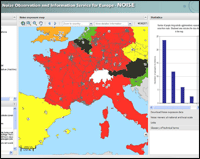Map on noise pollution in Europe

19/11/2009
The NOISE (Noise Observation and Information Service for Europe) viewer shows the number of people exposed to noise generated by air traffic, trains and car traffic in Europe and in 102 agglomerations with over 250,000 inhabitants. It currently contains data related to the strategic noise maps sent by member states in accordance with the European Directive 2002/49/CE on the assessment and management of environmental noise.
Noise can be found everywhere. The relationship between noise pollution and environmental pollution is currently being studied to determine the key factors - which are still underestimated - that are of serious consequences to our health. A prolonged exposure even to what is considered low levels of noise can cause serious problems such as high blood pressure and sleep disorders.
The European map of exposure to noise shows that half of the population living in urban areas with over 250,000 inhabitants is exposed to noise levels reaching over 55 decibels (dB) on the Lden indicator (measuring environmental noise during the day, evening and night and which is used to determine the negative effects of being exposed to noise). This represents over 41 million people.
Adopted in 2002, the Directive on Environmental Noise aims to reduce noise contamination, particularly in urban areas, as well as pinpoint quiet areas found both within urban areas and in rural areas. The Directive also regulates the conditions which must exist in areas near schools, hospitals and other buildings or areas considered to be sensitive to environmental noise. However, it does not focus on aspects related to the problems of noises caused by neighbours, domestic activities, or noises found at the workplace or related to public transport, which frequently are problems local administrations must solve.
The data gathered by EEA has been put together to offer a pan-European service which can be consulted online at the following site: http://noise.eionet.europa.eu/